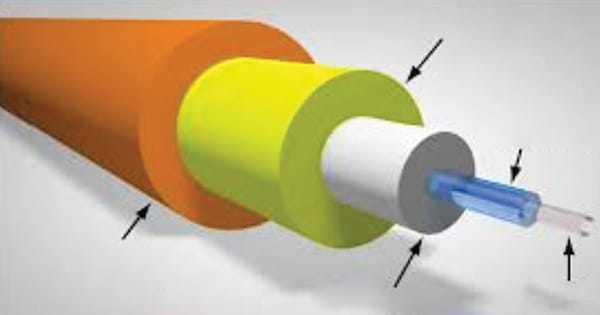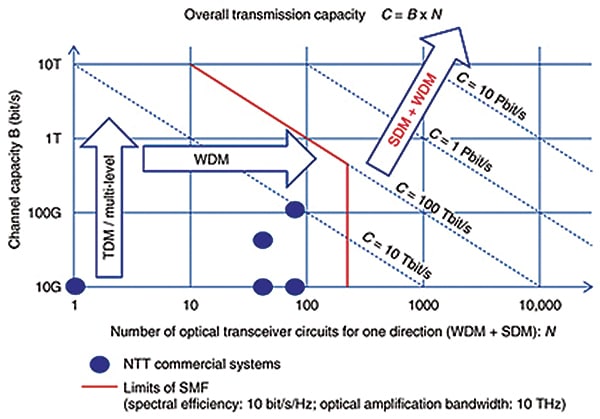The integration of multicore fibre and multiband optical networks could redefine data transmission, meeting our growing appetite for speed and capacity.
With over 65% of the global population now connected to the internet, data demand has surged to unprecedented levels. This relentless growth is fuelled by high-definition video streaming, extensive cloud computing, IoT, high-resolution multiplayer gaming, real-time online transactions, VR, and AR. Data transfer relies on three primary mediums: optical cables, copper cables, and wireless. While copper and wireless media suit short- to medium-range networks, optical fibre networks span thousands of miles, connecting cities, countries, and continents. The rapid expansion of internet users has pushed existing optical fibre infrastructure to its limits, necessitating the adoption of advanced technologies to meet future data needs.
Optical fibre: An overview
An optical fibre carries information signals as light pulses in the near-infrared spectrum and consists of multiple layers (Fig. 1):

Core. The central internal layer of an optical fibre through which light propagates. It is typically composed of high-purity glass and has a higher refractive index than the cladding
Cladding. The layer surrounding the core, with a slightly lower refractive index. Its purpose is to confine the propagated light through total internal reflection, ensuring minimal signal loss
Coating. A thin protective layer that shields the fibre from environmental damage, typically made from polymer materials
Strength member. Present in cables containing multiple fibres, such as aramid yarns, which are surrounded by coated fibres to provide tensile strength
Outer jacket. The external layer that safeguards the entire fibre assembly from damage, moisture, and other environmental factors
Based on different modes and refractive index profiles, optical fibres can be categorised into three types (Fig. 2):

Step-index single-mode fibre. A linear refractive index profile from the core to the cladding, supporting a single mode of data transmission
Step-index multi-mode fibre. A linear refractive index profile from the core to the cladding, allowing multiple modes of data transmission
Graded-index multi-mode fibre. A gradually decreasing refractive index profile from the core to the cladding, facilitating multiple modes for data transmission
Current optical fibre technologies are advanced yet approaching their limits. Traditional single-core optical fibres and the most advanced wavelength-division multiplexing (WDM) are also challenged by constraints in bandwidth, fibre thickness, and power due to non-linear effects. According to Nippon Telegraph and Telephone (NTT), Japan’s technical review, the maximum transmission capacity of WDM systems using single-mode fibre (SMF) has reached 100Tbit/s per fibre.
To meet the surging network bandwidth demand, a solution that can be seamlessly integrated with existing optical fibre communication networks is needed. This is where space division multiplexing (SDM) comes in, offering a new dimension in data transmission by enabling multiple cores within a single fibre and utilising multiple wavelength bands through WDM simultaneously.
Space division multiplexing
SDM is a multiplexing technique in fibre-optic communication that uses multiple spatial channels to increase network capacity. These channels operate independently, allowing simultaneous data transmission at the same frequency band within a single fibre. SDM can be categorised into three main types (Fig. 3):

Multicore fibre. Utilises different cores within an optical fibre to transmit data. Its design is more complex and costlier than single-core fibres
Multimode fibre. Uses different modes within an optical fibre, with data received through complex signal processing at the receiving end
Multimode and multicore fibre. A combination of the above techniques to further enhance the data capacity of an optical fibre
SDM in traditional single-core fibres can take various forms:
Reduced coating diameter fibre (RCDF). Maintains the cladding diameter at 125µm while reducing the coating diameter
Reduced cladding fibre (RCF). Reduces the cladding diameter compared to the standard 125/250µm cladding/coating diameter
Few modes fibre (FMF). Utilises three to four individual modes as transmission channels to boost fibre capacity
SDM can also be implemented in single-core fibres by increasing fibre density (i.e., packing multiple fibres within a fibre optic cable) or provisioning multiple modes in a single core for data transmission. However, these methods face capacity constraints, manufacturing complexities, and reduced cost-efficiency, which limit widespread adoption. Consequently, multi-core fibres (MCFs) have been developed to achieve better results with SDM.

Multicore fibre: An overview
MCF refers to an optical fibre containing multiple light-guiding cores within a single strand. It is designed to offer higher bandwidth capacity than traditional single-core optical fibre, enabling the transmission of multiple signals simultaneously. MCF’s design increases fibre density and bandwidth while maintaining the compact size of the optical fibre.
Based on core pitch (core-to-core distance), MCF can be classified into three types:
Strongly coupled MCF. Cores are placed very close to each other, causing significant optical coupling between them
Weakly coupled MCF. Cores are spaced apart, resulting in lower crosstalk between cores
Randomly coupled MCF. Cores are placed randomly within the cladding, causing irregular coupling characteristics. These MCFs are used in specialised applications
A 19-core MCF has been developed with a standard cladding diameter of 125µm. This fibre has been tested over a 63.5km distance, resulting in a data transmission speed of 1.7Pb/s. This MCF was developed through a collaborative project involving the National Institute of Information and Communication Technology (NICT), Japan, Sumitomo Electric Industries, Japan, and Macquarie University, Sydney.
An MCF designer must optimise core design, the number of cores, core arrangements, outer cladding thickness, and cladding diameter to balance the optical and mechanical properties of the fibre. Due to the complexity of parameter optimisation and manufacturing, any MCF deployment system requires fast, low-loss, and high-strength splicing capabilities for effective deployment.
Advantages of MCF over SCF
Key advantages of MCF over single-core fibre (SCF) include:
Increased data transmission capacity. MCF can transmit multiple signals simultaneously through its multiple cores, providing higher data transmission capacity than SCF
Reduced fibre footprint. Replacing multiple SCFs with MCF can reduce the physical space required for cabling in optical communication infrastructure
Cost efficiency of an optical communication system. Although MCF production costs are higher than SCF, MCF can significantly reduce the overall cost of optical communication systems
Better resource allocation and network traffic management. MCFs facilitate efficient resource allocation and better management of larger traffic, as each core can be dedicated to specific applications in an SDM system
Enhanced redundancy and reliability. An MCF offers built-in redundancy. If a specific core fails, another core can be used to maintain operation, thereby improving network reliability
Multiband optical network
Adopting MCF in place of traditional SCF addresses bandwidth challenges, but it is a capital-intensive (CAPEX) solution. Another approach is using multiband optical networks. Currently, most optical networks use the C-band (1530nm-1565nm) for data transmission, with some extending to the L-band (1565nm-1625nm) to increase bandwidth.
Multiband optical networks use multiple wavelength bands for signal transmission via WDM in standard optical fibre (Fig. 5). Utilising multiple optical bands enables these networks to achieve an overall bandwidth over ten times greater than conventional systems that only use the C-band.

Multiband optical networks offer increased data capacity, improved spectral efficiency, and enhanced network resiliency compared to single-band networks. However, challenges include the need for new multiband amplification techniques, new multiband transceivers, advanced control plane solutions, and efficient network planning and control.
Standardisation activities
Multicore fibre and multiband optical networks are emerging technologies with ongoing research and development, so standardisation activities remain limited. Nevertheless, ITU-T has proposed standards for initial SDM development.
According to the ITU-T technical report, GSTR-SDM – Optical fibre, cable, and components for space division multiplexing transmission:
For SDM optical fibre links, the following entities must be harmonised for a physical layer standard:
1. [IEC SC 86B]
2. [IEC SC 86C]
3. ITU-T Q6/SG15
4. ITU-T Q2/SG15
Achieving very low crosstalk with a relatively simple refractive index profile while maintaining a cladding diameter of 125µm may be difficult. However, optical compatibility with existing ITU-T G.652, ITU-T G.654, and ITU-T G.657 fibres is essential.
Applications
The applications of multicore fibre and multiband optical networks are extensive, including:
Data centres. MCF and multiband optical networks provide high-density, high-speed connectivity between in-house devices, such as servers, switches, and storage devices
Multicore fibre lasers, amplifiers, and optical sensors. These optical instruments can be designed with high accuracy, high resolution, compactness, stability, reproducibility, and reliability using MCF technology
Biomedical sensing and imaging. Widely used in medical applications, such as imaging and diagnostics, to provide high-speed and high-resolution data for testing
Experimental physics. MCF is used for testing various phenomena in fields such as quantum mechanics, the Anderson effect, and fluid dynamics experiments
Passive optical networks (PON). MCF helps increase fibre density and addresses cable size limitations and duct congestion issues in PON. It can be used between the optical network terminal (ONT) and optical line terminal (OLT) of an optical distribution network (ODN)
Singal processing. MCF is used for various signal processing operations, including pulse shaping, modal conversion, and dispersion engineering
Challenges associated
Every new technology comes with both advancements and challenges. Major challenges in MCF and multiband optical networks include:
Crosstalk between cores. Signals from one core can interfere with neighbouring cores, potentially causing data loss
Need for advanced signal processing. Transmitted data from MCF or multiband networks must be received separately at the receiver’s side, which involves complex signal processing to mitigate crosstalk and ensure reliable data transmission
Limited industry acceptance. MCF cannot be directly spliced with single-mode fibres, limiting its industry adoption
Higher cost of manufacturing. MCFs require optimising multiple parameters, making them more expensive than SCFs. A 7-core MCF can cost double the cost of seven single-core fibres
Need for amplification techniques. MCFs and multiband networks require compatible optical amplifiers to fully utilise these technologies
Limited transmission distance. MCFs are primarily used for shorter distances, such as within buildings, due to higher signal attenuation over long distances compared to SCF

Future with the integration of multicore fibre and multiband optical networks
According to an article on SDM by NTT, Japan, existing SMF-based commercial systems have reached a channel capacity of up to 100Gbit/s using time division multiplexing (TDM), with approximately 100 multiplexed optical transceiver circuits, yielding a total transmission capacity of 100Tbit/s.
Current technology has reached its maximum capacity, necessitating new research and development. Integrating SDM and WDM presents a promising solution.
Combining MCF with multiband optical networks enables the use of SDM (from MCF) and WDM (from multiband networks), increasing system transmission capacity (Fig. 6) at the cost of requiring more optical transceiver circuits.
Data demand is escalating, and current technology is approaching its limits. To meet future bandwidth needs, integrating MCF and multiband optical networks is crucial. These technologies will redefine fibre-optic communications, boosting connectivity and increasing data transmission capacity while overcoming infrastructure challenges.
Suryansh Pratap Singh is a Scientist ‘B’ at the Centre for Development of Telematics (C-DOT), the research and development centre of the Government of India. He earned his B.Tech degree in Electronics and Communication Engineering from MNNIT Allahabad.
Arka Mukherjee is a Scientist ‘E’ and Team Leader at the Centre for Development of Telematics (C-DOT), the research and development centre of the Government of India. He possesses over 12 years of experience in designing embedded systems for optical access networks and quantum key distribution systems.





